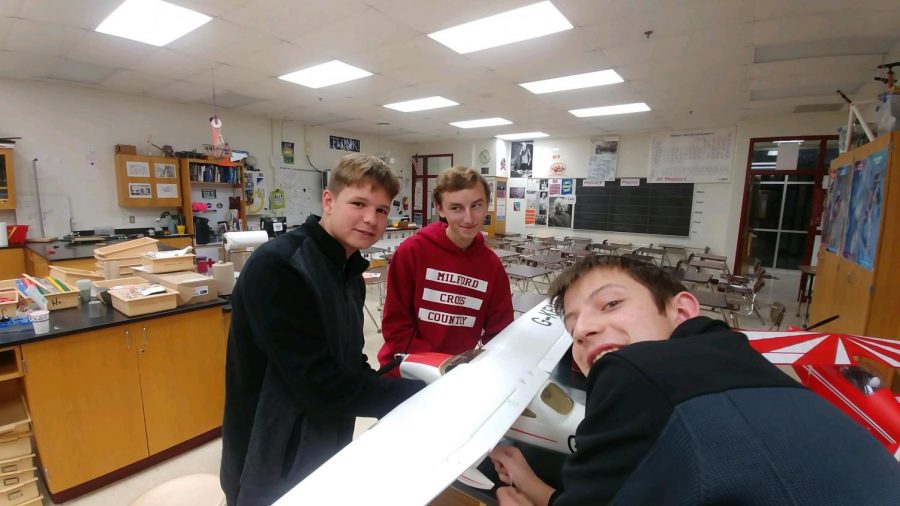Student forms club to fly remote-control vehicles
Left to right) Evan Thompson, Dylan Hoorn, and Nick Blanchard working on an aircraft
December 20, 2019
Out on the field, the sky’s the limit. It is the only restriction of flight, especially for RC aircrafts. These vehicles are radio controlled and flow from the ground by remote operators. Here at Milford, that operator is typically Junior Zach Blanchard, founder of the MHS RC club.
This year, Blanchard started an RC club at Milford in order to fly/drive these vehicles with friends and provide other students with the opportunity to try RC operating, free of cost. The members of the club meet on Wednesdays from 4-6 p.m. to get together and discuss, drive, fly, and work on various RC vehicles, which include everything from aerobatic drones to model airplanes to cars.
The club teaches students skills that can be applied to the greater field of engineering. By learning how to control these vehicles, students can comprehend the mechanics that make them work.
To understand this, it is first important to know how an RC vehicle functions. Basically, the vehicle controls respond to radio signals that are sent from the transmitter (TX) to the receiver (RX). The transmitter is the remote control that is held by the operator, while the receiver is on the vehicle itself. In order for these systems to function, both the TX and RX need to operate on the same frequency (typically measured in megahertz), which is determined by a system called a crystal, the small component that regulates which channel number an aircraft will fly on.
However, not all crafts use megahertz systems; another common one is the spread spectrum structure. Vehicles operating using this technology use the 2.4GHz (gigahertz) frequency band in order to avoid radio interference, which is common on MHz ranges. This structure also forgoes the use of a crystal, because the frequency is predetermined.
Both of these systems serve to send out signals that are picked up by the RX and forwarded to the servos and electronic speed controller, from which they are converted to physical movement, allowing the plane or car to respond to the driver’s instructions.
This is just a basic overview of RC vehicles, and students in the club learn about these things in much more depth. However, from this, it can be synthesized that knowledge of these mediums would help kids with other engineering feats, which is one of the ultimate goals of the club.
The club also aims to provide a fun hobby for students. “The blend of these two things [engineering skills and the lack of costs] into a relaxed and inviting atmosphere makes it a great place to unwind after school where you can hang out with friends,” Blanchard said.
Other members shared the same fondness for the club. Junior Eddie Macdougall described it as an, “Enjoyable two hours where I get to fly planes.” Another Junior, Katie Guscar, who has only had the privilege of attending one meeting thus far due to scheduling conflicts, said, “I had a lot of fun. I learned a little bit, and it was definitely something I would enjoy doing more often. I would definitely recommend it for many students.”
Right now, the club has eight members after fewer than three months of operation. They are looking to expand, and welcome anyone with interest to drop by during a meeting, even if it’s just to see what they do. The club’s times are flexible, and participation requires no future commitment or guarantees. So, if RC vehicles are of interest, stop by Milford’s newest group, the RC club.
